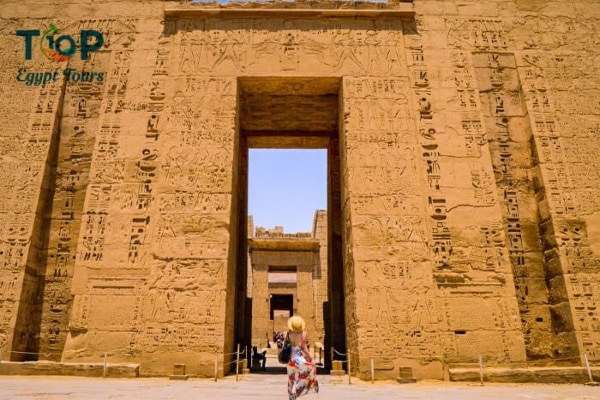The Temple of Medinet Habu is a magnificent structure that stands as a testament to the grandeur and power of the ancient Egyptian civilization. Located on the west bank of the Nile River in Luxor, this temple was built during the reign of Ramses III, one of the most powerful pharaohs of the New Kingdom period. The temple complex covers an area of over 20,000 square meters and is surrounded by a massive wall that serves as a fortress to protect the pharaoh and his people.
In this article, we will uncover for you the Temple of Medinet Habu with Top Ten Egypt.
Walls that Speak: Unveiling the Ancient Stories Carved in the Temple of Medinet Habu
The walls of the Habu Temple are adorned with intricate carvings and hieroglyphs that tell the stories of the pharaohs and their conquests. These carvings depict scenes of warfare, religious rituals, and daily life in ancient Egypt. One of the most impressive features of the temple is the depiction of the Battle of the Delta, which shows Ramses III leading his army to victory against the invading Sea Peoples.
The Warrior King’s Legacy: Discovering the Reign of Ramses III at the Temple of Medinet Habu
Ramses III was known as a warrior king who led his army to numerous victories during his reign. The Temple of Medinet Habu was built to commemorate his achievements and to serve as a place of worship for the gods. The temple is divided into several sections, each dedicated to a different deity. The main temple is dedicated to the god Amun, while the smaller temples are dedicated to other gods such as Ptah and Hathor.
Architectural Marvels: Exploring the Design and Construction of the Temple
The Temple is a masterpiece of ancient Egyptian architecture. The temple complex is built in the traditional Egyptian style, with massive columns, towering pylons, and intricate carvings. The temple was constructed using sandstone and limestone, and the walls were covered in brightly colored paint. The temple’s design is a testament to the skill and ingenuity of the ancient Egyptian architects and builders.
Sacred Artistry: Appreciating the Intricate Reliefs and Hieroglyphs at the Temple of Medinet Habu
Habu Temple is a treasure trove of ancient Egyptian art. The walls are covered in intricate reliefs and hieroglyphs that depict scenes from ancient Egyptian mythology and history. The carvings are so detailed and intricate that they seem to come to life, telling the stories of the pharaohs and their gods.
A Journey to the Afterlife: Tracing the Funerary Rituals at the Temple of Medinet Habu
The ancient Egyptians believed in the afterlife and spent a great deal of time and effort preparing for it. The Temple of Medinet Habu was built to serve as a place of worship and to facilitate the pharaoh’s journey to the afterlife. The temple is filled with depictions of funerary rituals, including the weighing of the heart ceremony, which determines whether the deceased would be allowed to enter the afterlife.
The Living Museum: Experiencing the Historical Treasures of the Temple of Medinet Habu
It is a living museum that offers visitors a glimpse into the ancient world of the pharaohs. The temple complex is filled with historical treasures, including statues, carvings, and artifacts that have been preserved for thousands of years. Visitors can explore the temple and learn about the history and culture of ancient Egypt.
Guardians of the West Bank: Understanding the Strategic Importance of the Temple
The Temple of Medinet Habu was strategically located on the west bank of the Nile River, which was considered the land of the dead in ancient Egyptian mythology. The temple served as a guardian of the west bank, protecting the pharaoh and his people from evil spirits and other dangers. The temple’s massive walls and imposing pylons served as a warning to any would-be invaders.
A Glimpse into Pharaonic Warfare: Exploring the Military Scenes at the Temple of Medinet Habu
The Temple of Medinet Habu is filled with depictions of pharaonic warfare, including scenes of battles and conquests. The carvings show the pharaohs leading their armies to victory against their enemies, including the Sea Peoples and the Libyans. These scenes offer a glimpse into the military might and strategic prowess of the ancient Egyptians.
In conclusion, the Temple of Medinet Habu is a must-see destination for anyone interested in ancient Egyptian history and culture. The temple complex offers a glimpse into the world of the rulers and their achievements, and it serves as a reminder of the enduring legacy of one of the world’s greatest civilizations. Whether you are a history buff, an art lover, or simply a curious traveler, the Temple of Medinet Habu is sure to leave a lasting impression.
Browse our complete list of Egypt tours and join our Day Trip to Luxor by Plane from Cairo.



Comment (0)